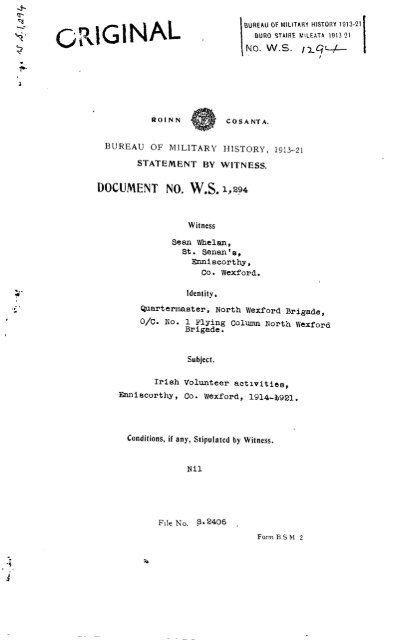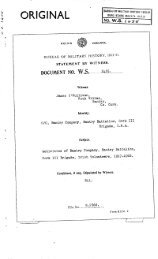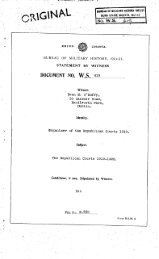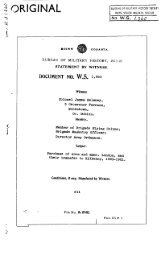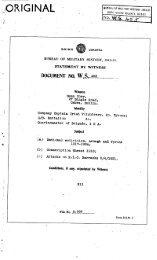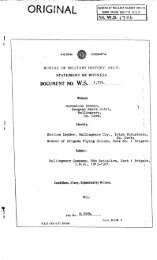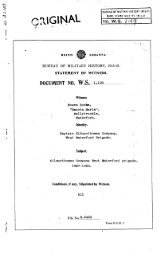ROINN COSANTA. BUREAU OF MILITARY HISTORY, 1913-21 ...
ROINN COSANTA. BUREAU OF MILITARY HISTORY, 1913-21 ...
ROINN COSANTA. BUREAU OF MILITARY HISTORY, 1913-21 ...
Create successful ePaper yourself
Turn your PDF publications into a flip-book with our unique Google optimized e-Paper software.
<strong>ROINN</strong><strong>COSANTA</strong>.<strong>BUREAU</strong> <strong>OF</strong> <strong>MILITARY</strong> <strong>HISTORY</strong>, <strong>1913</strong>-<strong>21</strong>STATEMENT BY WITNESS.DOCUMENT NO. W.S. 1,294WitnessSeanSt.Whelan,Senan's,Enniscorthy,Co. Wexford.Identity.Quartermaster, North Wexford Brigade,0/C. No. l Flying Column North WexfordBrigade.Subject.Irish Volunteer activities,Enniscorthy, Co. Wexford, 1914-19<strong>21</strong>.Conditions, if any, Stipulatedby Witness.NilFile No. S.2406Form
SECOND STATEMENT BY SEAN WHELAN,St. Senan's, Enniscorthy, Co. Wexford.My mother's father, James Tomkins, Tombrick,Ballycarney, was a of member the Fenian Brotherhood,and was waiting, with his Schneider rifle, in 1867for the call that never came. His sons, Jack and Patjoined the Volunteers at their inception. Jack wassentenced to death - commuted to penal servitude forlife - for shooting the cap from the head of SergeantCunningham, R.I.C., when a party of R.I.C. surprisedVolunteers who were about to blow up Edermine bridge-three miles south of Enniscorthy- during Easter Week1916. Pat took part in the Rising and was interned.Thanks to my mother's great fund of Irish songsand ballads, I was familiar with Ireland's strugglefor independence long before I could read or write.And when the call came on that memorable day in thespringtime of the year 1914, there were no impedimentson the way to my lips of the affirmative answer thatleft my heart in reply to Pat Keegan's request that Ijoin the Irish Volunteers.Pat was the son of an I.R.B. man - GeorgeKeegan - and his Uncle Tom was an I.R.B. man too andwas preaching sedition, for forty years before theRising, to the youth of Enniscorthy who had the goodfortune to stop, look and listen, on their way homefrom school, at Keegan's cooper's shop at No. 10 Irish
-2-Street, where all the milk churns, firkins, tubs, etc.,were made by Pat and his uncle, from best American oak,for the farmers and dairymen of Enniscorthy anddistrict.We drilled and paraded, paraded and drilled,during the spring and summer of 1914. Then, on a Julyday, a Serbian student fired a revolver at an Austrianarchduke in an unknown Balkan town. Germany heardthis shot, and August saw her declare war on France andstride like a colossus across Belgium.September heard John Redmond, leader of theIrish Parliamentary Party and a member of the VolunteerExecutive, urging every member of the Irish Volunteersto don khaki and fight for little Belgium.This caused a split in the Volunteers, andOctober saw the I.R.B. strike back by seizing VolunteerGeneral Headquarters and kicking out Redmond and hisclique.One section at the Volunteers followed Redmondand became the Irish National Volunteers.The anti war section became the Irish Volunteers.There were about forty of us in this section. SeamusRafter was our Captain, and Pat Keegan, 1st Lieutenant.The old '98 Club in Mary Street was taken over as ourheadquarters, where we began to work for insurrection.Working parties, munition parties and foraging partieswere formed, with Keegan in charge.Davis's foundry was the first victim of theforagers. We purloined a crucible there. Lead we
-3-took from anywhere we found it. Jem Cleary mademoulds and began to run buckshot. Large quantities ofbuckshot cartridges were made, and we carried them tomany parts of Co. Wexford.On one occasion, Pat Keegan, John Cleary,M. Davies and I with cycled,two hundred and fiftybuckshot cartridges on each carrier, over twenty miles toCaptain Kehoe, Skeeter Park, Co. Wexford, away up inthe mountainous district of the Three Rocks.Keegan's house (No. 10 Irish Street) was knownto all the initiated as "the munition dump". It washere that the buckshot was run and cartridges filled,pikeheads sharpened and handles fixed.The pikeheads were made by Jim Cleary at hisforge in Reilly's yard at the top of the old ChurchRoad - now St. Senan's - and we carried them in sackson our backs as we waded across the Slaney at a placeknown as the Point of the Island.Work went on every night (except Sunday) atKeegan's. We constructed a cave in Keegan's yardwhere we stored all the pikes, cartridges, crude bombsand shotguns. The shingle that we dug from the cavewas filled into sacks and formed a barricade acrossthe yard. Behind this first line of defence, one ortwo Volunteers did "sentry go" every night with ordersto fire on any R.I.C. man who dared to lift the latchof the door that led out to Keegan's yard. CaptainRafter made most of the powder that went into thebuckshot cartridges. It was known as "the devil".We captured four kegs of gunpowder in a raid on
-4-Donoghue's stores, Templeshannon. Liam Mellows camedown from Dublin and took away two of them.One night towards the end of the summer of 1915,Keegan asked me to remain on at the "munition dump"after the other workers had gone home.Joy of Joys He presented me with a long LeeEnfield rifle and twenty-five rounds of .303 and toldme to defend it with my life.I brought my prize home and fondled and caressddit, as a lover would his bride. I placed it in asecure hiding place that I had been preparing for quitea long time, in anticipation of this event - there toawait the dawn that surely must be near now.P.H. Pearse came to Enniscorthy in 1915 and I amnot sure whether it was Emmett's birth (March 1778) orhis death (September 1803) we were commemorating.Pearse was accompanied by The O'Rahilly. They weremet at the railway station by twenty-five uniformedVolunteers who escorted them to the "barley field", atthe foot of Vinegar Hill, where Pearse addressed andinspected A. and B. Companies. It was here I firstheard "The Soldiers' Song". The singer was TomStokes, a member of A. Company.That night, at a concert in the Athenaeum,twenty-five uniformed Volunteers carrying rifles formeda guard of honour for Pearse.I think it was about this time that the greatIrish patriot, O'Donovan Rossa, died, and forty (A.Company) Volunteers in uniform marched behind theremains to Glasnevin where I heard Pearse deliver the
-5-oration.We had many route marches, sham battles, etc.to toughen us for the coming fight that we, the rankand file, suspected was just "round the corner".About four weeks before Easter 1916, we had aroute march to the ancient city of Ferns. It waswhile I was exploring the ruins of Dermot McMurrough'scastle in that city, I was approached by Keegan andJim Cullen, Captain of B. Company, arid asked to jointhe Irish Republican Brotherhood. Cullen administeredthe oath to me.On Spy Wednesday, A. Company received orders tobe ready for a route march on Easter Sunday morning.This was to be a route march with a difference. Wewere to carry full equipment and two days' rations.The full equipment part of the order was cancelledlate on Holy Saturday night.We marched round Vinegar Hill on Easter Sundaymorning, and dismissed in Mary Street at midday.On Easter Monday, Dame Rumour came to town andfilled the air with news of Volunteers fighting inthe streets of Dublin and Germans landing in Kerry.Our officers met many times on Monday arid Tuesday whenit was confirmed that the Volunteers had taken theG.P.O. Though they talked it out all day Wednesday,it was midnight before they finally made up theirminds to rise.We paraded in Mary Street at dawn on Thursdaynorning, and marched to Keegan's where the cave gaveup its secrets to all the uninitiated. Shotguns,
-6-pikes and bombs were distributed to all those who hadnot got rifles. We then marched to the Athenaeumwhere we hoisted the tricolour, saluted it with threevolleys and three ringing cheers, establishedheadquarters, controlled the town and posted outpostsat the approaches.Some writers say that we occupied historicVinegar Hill and that we made no real effort to rousethe country or to maintain the initiative. Thosestatements are not true.The R.I.C. barricated themselves in theirbarracks, and most of us who had rifles amused ourselvesby taking pot shots at them from two positionsoverlooking the barracks, the Turret Rocks and the topof Castle Hill. The police returned the fire, andone of our bullets found a billet in the leg of oneof the defenders, Constable Grace. We allowed adoctor to go into the barrack to treat ins wound, buthe did not succeed in saving the constable's leg as itwas amputated after the surrender.Recruits flowed in to the Athenaeum from everypart of the district. We armed most of them with pikesandshotguns.On Friday we extended our line to Ferns and hadalmost reached Gorey when Dame Rumour came toEnniscorthy again on Saturday and told us that theVolunteers had surrendered in Dublin and that Britishtroops had landed in Wexford and were marching onEnniscorthy.When both those rumours were confirmed on
-7-Sunday morning, a deputation of prominent townspeopletook it on themselves to interview General French,Officer Commanding t1e British troops in Wexford.Fr. Fitzhenry, Adm., Canon Lister, Pat Shaw, T.C.,John Bolger and Pat O'Neill are some of the deputation.They returned to Enniscorthy with terms of surrender -unconditional - and official confirmation of the rumourthat Pearse had surrendered in Dublin and was aprisoner in Kilmainham prison. Our officers doubtedthis, and were granted facilities to interview Pearsein Kilmainham prison.Seamus Doyle and Set Etchingham (accompanied byConstable Drake, R.I.C.) were those who saw Pearse inDublin. He confirmed the order to surrender, butwhispered to Seamus Doyle, "Hide your arms. You willneed them again".On their return to Enniscorthy, a council of warwas held In the Athaneeum. Keegan was there and tried hardto be allowed to form a Flying Column and take to thehills. It was finally decided to disband the rank andfile, the officers to surrender to General French. Allarms were called in and laid on the floor of theAthenaeum.Early on Monday morning, my brother, Jem, and Ireturned to the Athenaeum, just to have one last lookround before the British came to town. We found theplace deserted. Confusion reigned supreme. Scatteredall over the floor were scores of mattresses, hundredsof blankets and sheets, clothing, food, mugs, plates,etc., scores of pikes, many shotguns, bombs and a fewancient and modern revolvers. We noticed at once that
-9-We found him standing at the cottage gate,seeking news of the Rising from those who passed by.When we told him of the surrender, he rushed into thecottage, whipped an old quilt from off his bed,wrapped it round the rifles and we hid them in theheavy undergrowth of Pat Doyle's orchard close by -there to await another day which we thought might comein our time.When we returned to Enniscorthy a few hourslater, we found about a thousand British troopsloitering round the Market Square. The police hadcome out from behind their barricades and were makingarrestswholesale.Arrests went on, day and night, night and day,until every known Volunteer was behind prison bars.Jem and I were not arrested, though we were well knownVolunteers and had paraded in uniform dozens of times.Almost forty years have elapsed since those eventstook place, and we are still wondering how we came tobe overlooked in this Easter round-up.I should like to mention that the Irish NationalVolunteers in the town of Wexford gave every assistanceto the British troops from the moment they landed inthattown.On the Monday following Easter Week, I returnedto my place of employment, and the boss informed me thatmy services were no longer required, so I folded mytent, like the Arabs, and silently stole away, to workfor an army contractor, named Warner, who had thecontract of repairing all the boots for the troops in
-10-the garrison town of Newbridge in the County ofKildare.I was only a few months in this job when Idiscovered that an odd revolver and an occasional riflecould be bought from the hard-up soldier who waswilling to break the seventh commandment for an"honest" pound. But the fight was over, and all myfriends were in prison, so I did not bother, but"shelved" the knowledge of my discovery for futurereference.I did not return home to Enniscorthy until thesummer of 1918, and I found all the old parties-munition working and foraging- in action again andworking at top speed in a new munition dump up in theattic of Antwerp- a pet name for VolunteerHeadquarters.When I told Keegan of my "shelved" Newbridgediscovery, he was jubilant, and the necessary cash wasimmediately forthcoming from the private pocket ofSeamus Rafter. I purchased many rifles and somerevolvers and an occasional clip of .303 ammunition inNewbridge and The Curragh.Sean Gallagher, a native of The Shannon,Enniscorthy, was working in Baltinglass at the time,and occasionally came to Newbridge to collect mypurchases.On one occasion, a native of Naas (a few milesfrom Newbridge), named Tom Traynor, employed in theCo-Op. Stores, Enniscorthy, at the time was home onholidays and called on me at Newbridge, and we cycled
-12-and, after a journey of many minor adventures, wearrived back in Enniscorthy two days later.We captured many shotguns and miniature riflesin raids on loyalist houses during the winter of 1919-1920.Then there arrived in Enniscorthy the mostfearless soldier I have ever known. His name was JoeMcMahon, Kilmaley, Co. Clare. He was a coach-builderand was employed at Breen's of the Rock factory. Fromthe moment of his arrival, business in A. Company wasbooming! He was action, ACTION, A C T I 0 N!!He often chided us on resting on our '98 and 'lolaurels, while the men of Dublin, Clare, Cork, Tipperaryand Kerry were pouring out their life-blood in the fightto drive out the English. I pleaded many excuses thatincluded shortage of ammunition and bombs.Then he produced his plan of the "tallerpercussion bomb". These bombs were made from steelpiping and were six inches long by five inches incircumference, plugged at both ends with wooden plugs,and a three-inch nail acting as the percussion pin.The bomb was fitted with a tall, eighteen inches long byone inch wide, to ensure that it fell on the pin,causing the detonator to explode and set off thegelignite. The bomb was thrown by catching it bythe tail and swinging it above the head three or fourtime, before letting it go.We formed a bombing party, with Joe in charge,and practised with dummy bombs at the haunted house,
-13-a little frequented two-storied stone structure,situated on the west bank of the Slaney, about one anda hilf miles up-stream from Enniscorthy. From fiftyyards range, we could land a bomb on the roof, and Joescored an occasional "bull" down the chimney.It was Joe McMahon who opened the attack onClonroche R.I.C. barracks on a night in April, 1920.We were amazed to hear only about one in ten of our"taller" bombs exploding.The gelignite used in these bombs had beencaptured in a hold-up on the Wexford County Council'sEngineer's car, about one year previous, and had beenhidden in a tomb in Ballybrennan graveyard. When weresurrected it from the tomb one year later, we foundit frozen; and we thought we had thawed it back tolife when we cooked it on hot iron plates over an openfire at Albert Smyth's home in Tamalosset where all thebombs were made. (One of the "cooks", Joe O'Brien,Tailor, Duffry Gate, Enniscorthy, is still - thirty-fiveyears after -suffering from headaches caused by thefumes of the nitro-glycerine.)I should have known that this gelignite wasundependable as, sometime before the Clonroche attack,I saw a live bomb accidentally roll off the work-benchat Albert Smith's and strike the floor at my feet -and only the detonator exploded! We said, "Thank God",for that escape, but I am afraid it wasn't a prayer wesaid at Clonroche. The failure of the bombs wasresponsible for the unsuccessful attempt to capture
-14-thispost.The plan of attack was that the bombers shouldattack the back and, when we had made a hole in the roof,bottles of oil and petrol, equipped with tails like thebombs, were to be thrown on to the roof in the samemanner as the bombs, followed by blazing torches. Aswe had no alternative plan, we reluctantly withdrew afterabout two hours. Every shot in our bomb locker wasfired that night, and we never made another "taller"percussion bomb. As far as I remember, T.D. Sinnottwas in charge of the attack.Joe's next big job was when we accompanied twoG.H.Q. officers, Frank Thornton and Liam Tobin, on theexecution of District Inspector Lee Wilson, R.I.C., atGorey in June, 1920. I have written a special accountof this operation, but I omitted to mention two veryimportant people who made it possible for us to make itthe great success it was.Brigade Adjutant Liam O'Leary, Main Street,Enniscorthy - it was he who went to Gorey a few daysbefore the execution, scouted the position and collectedinformation concerning the District Inspector's dailytimetable and habits.In a raid on Enniscorthy railway station in May,1920, we captured about two hundred two-gallon tins ofpetrol and took them away in M.J. Whelan's (not relatedto the writer of this) lorries and stored it at MissMary O'Neill's home at Ballingale, near Ferns. It washere we replenished our supplies of petrol at the end ofeach day's search for Wilson. Mass O'Neill knew of our
-15-mission, and I would like to say thanks for the many teasand lunches that were given to "Wilson's men".I am not sure whether it was before or after theWilson affair that Joe, accompanied by Tom Roche andFrank Gibbons, called at my home at No. I Irish Street,where I kept a boot repairing shop, and reported that twoarmed members of the R.I.C. from the village of Clonrochehad gone into Ringwood's barber's shop at Templeshannon -presumably for a hair-cut - and asked me to give them the"green light" for a hold-up. I put Joe in charge andgave him my colt .45 revolver, and said, "Go ahead". Itold him to collect Michael Kirwan, Matt Lynam and JemFitzharris on the way over, just in case there was a fight.There was a fight, but not at the barber's.When Joe got to Ringwood's, he noticed that therewere five or six other people in the shop. Fearing thatsome of these might lose their lives if the policerefused to surrender, he decided to ambush them as theyreturned to Clonroche. He selected a good ambushposition near the Golf Links at Red Pat's Cross, on theEnniscorthy-New Ross road. They had only taken up theirpositions when the two R.I.C. men came cycling along.Just as they were about to enter the ambush, one of theVolunteers accidentally discharged his revolver. Thepolice immediately threw themselves off their bikes anda tough fight ensued. The police tried an outflankingmovement. Joe ordered a retreat when his men ran outof ammunition. The Volunteers had only revolvers andno refills of ammunition. We were all very disappointedat the failure of our first ambush.It was in the pleasant month of August, 1920, that
-16-Joe McMahon and I decided to raid the Tower of Hook, a main-lanlighthouse at the most southerly point of Wexford,and take away all the tonite and detonators there.Tonite is an explosive used to warn ships in time of fog.It is a white chalklike substance arid is made up insix-inch lengths by five inches in circumference. Thecar we used on this job was lent by the Rev. Fr. Walsh,Coolfancy, and the driver was Bill Sheridan, Irish Street,Enniscorthy. The sun had not gone down when we arrivedat the Tower. Joe, as usual, was first into action andled the way into the Tower. The keeper offered littleresistance. Bill Sheridan kept them covered whileJoe and I carried out the tonite and detonators. Weleft enough tonite for a twelve-hour fog, dismantled thetelephone and told the keeper not to move for two hours.We started off for Enniscorthy where we arrived withoutmishap, and discharged our cargo at Antwerp.This raid had a tragic sequence some months later.Some of the tonite was later sent to Saltmills, a littlevillage, about ten miles from the Hook. It was storedin an unoccupied house on farmer Cowman's out-farm.One night, about a dozen Volunteers had assembled intheir house for the purpose of making bombs in preparationfor an attack on Tintern R.I.C. barracks. Somethinghappened which caused all the tonite to explode with aterrifying report that illuminated the night sky and wasseen and heard many miles away. With the dawn, it wasseen that the house - a stout stone structure - haddisappeared and the remains of six Volunteers werescattered over the countryside. There were a few badlywounded survivors. These were arrested and throwninto prison. I met some of them in Cork detentionbarracks in 19<strong>21</strong>. Though they were all young men in
-17-their twenties, that one moment of terror had addedthirty years to their age.The autumn of 1920 was about a month old when Iwas promoted Quartermaster, North Wexford Brigade.About this Lime, I intercepted a letter addressedto: Officer Commanding the Troops, Courthouse,Enniscorthy. The 0/C, Troops, was the infamous CaptainYeo - an unprincipled scoundrel who allowed his troopsto torture prisoners. They were the terror ofEnniscorthy and they sometimes ran amok in town, usingentrenching tools as batons to bludgeon those who wereunfortunate enough to come in their way. One or twoVolunteers were kept in the courthouse, arid we believedthey were being kept there as hostages, and it wasbecause of those that Captain Yeo was able to boast thathe had gone through the "Irish" war and kept his hideintact.When I arrived (a prisoner) in the courthouseon the evening of the 6th November, 1920, I was throwninto a cell with Val Martin Kelly, Ballycarney. Therewere no beds, only a few old mattresses sent in by ourfriends outside. The floor was concrete and thebedclothes and food were supplied by the local Cumannna mBan. (Thank you, Miss Teresa' Keegan, and yoursister,Ellen!)I noticed there was much blood on the floorand walls, and asked Martin to explain. He told methat, when he arrived there a few days previously, oneof the soldiers, known as "Lofty" (he was six feet, sixinches tall) came into his cell and beat him up, byknocking him down and forcing the barrell of a loaded
-18-.45 revolver into his mouth, cutting his gums, palateand tonsils. He told me too that every prisoner wasgiven a "bath", a "hair-cut" and a "hiding".I did not sleep that night and, when morning came,Private Seaman (a low-bred scoundrel, if ever there wasone!) came into my cell, carrying a hair-cutting machine.When he went out ten minutes later, the longest hair onmy head was less than five-sixteenths of an inch.Before he left, he ordered me to get ready for a bath.The bath was a terrible ordeal. I was taken,naked, out of my cell and, as I walked along the flaggedcorridor and down the stone steps that led out to anopen yard, I swore that, if ever I got free from theclutches of those demons, I would ......... No, I'llnot write what I swore! Time is a great healer ...!There were about a dozen soldiers standing round,laughing and jibing. Five or six buckets had been filledwith cold water from a tap in the wall. I was orderedto stand in a small, shallow basin, filled with soap-suds,in the middle of the yard. One of the soldiersstepped forward and, picking up one of the buckets,dashed its contents into my face. Other soldiers triedto knock me down by emptying the remaining buckets overmy body. They then forced me to run round the yard,beating me with towels as I ran. Some of them heldbrush handles, thigh high, and forced me to jump overthem. I don't know how long this torture went onbut, when I was allowed to go back to ray cell, I feltsome of the joy experienced by a soul being releasedfromPurgatory.
-19-The following night-they did most of theirdirty work at night-time-they brought in MartinCarty, Slaney Street, and beat him for hours outside mycell door. When I saw him next morning, I hardly knewhim, with what lumps and bruises were on his head andface.Two nights later, they brought in Albert andLoftus Smyth, Tomalosset. They were placed in my cell.Private Seaman and a few others came in, armed withwooden cudgels, and gave those two brothers a very badbeating. They forced them to take off their boots, andthey beat them on the toes and on the head with thecudgels.Patsy O'Neill, Irish Street, was brought in andgiven a bath, with his clothes on. They gave him a"hair-cut", punched his eyes, threw him out on the street,and told him to go home -luckydevil!Fr. Codd, Adm., The Manse, Enniscorthy, (nowCanon and P.P., Ferns) called to see me and was escortedto my cell by two soldiers who remained during hisvisit. I must have looked in pretty bad shape, as heasked if I would like to go to confession. I repliedI would love to. He asked the soldiers to leave thecell. They refused but, after a few minutes'reasoning with them, they compromised by consenting tobring Captain Yeo. The Captain came and was very"nice" about it - "Yes, of course! Why not!". Wecould have all the confessions we wanted but only onone condition, that he be present during the confession!!It is unnecessary to say what Fr. Codd thought of thiscondition. He gave me his rosary beads - I have it
-20-still and treasure it with pride - and his blessing, andleft at once.I was in this veritable hell of mental andphysical torture for about three weeks before beingtransferred to the military detention barracks, Cork.It was one of the high spots in my life to stand andwatch the courthouse go up in flames before we (theRepublicans) evacuated the town in the Civil War of 1922.The courthouse was rebuilt about twenty years ago. Thelocal court is held there every second Wednesday, andDonagh McDonagh, a son of one of the 1916 leaders, sitsthere in judgement on the local law-breakers.To revert back, however, to the episode of theintercepted letter. It contained the following note:- "DearSir, When you are arrestingMichael Kirwan who works at JohnieKenny's, Chapel Street, be sure andplace a guard at Joe Hendrick's lanethat leads out to Irish Street, asKirwan can escape by this lane."Kirwan was a well known Volunteer. I am not sure ifthe letter was signed, but the person who gave it tome - Michael Murphy, Ross Road, Enniscorthy, employedat the time at Rafter's, Main Street, Enniscorthy- toldme that it was written by a farm labourer named JamesDoyle, Ballycarney. I asked Murphy where he got it,but, unfortunately, I have forgotten his reply.I decided at once to set a trap for Doyle, and Iasked Tom Roche, saddler, Templeshannon, and my brother,Jem, to spring it. Sometime previously, we had
-<strong>21</strong>-captured British army officers' uniforms in a raid forarms on a loyalist house. We dressed Tom and Jew inthe uniforms, and we started off for Doyle's home. Itwas rather late when we arrived there, and Doyle was inbed. His wife answered our knock, and we told her thatwe were officers of the courthouse garrison and we hadcome in response to a letter written by her husband toour commanding officer. Doyle was out of bed anddressed in a few minutes, and we asked him to come out.on the road, as we did not wish to discuss the matterin the presence of his wife.It was a lovely moonlight night, and the"officers" had to be very careful as Doyle knew both ofthem, but they acted their parts well, so well, in fact,that two local Volunteers - not in the know of our mission -who happened to be coming along the road, on hearing theEnglish voices, scrambled over the ditch and took to thefields. Doyle told all he knew about the area and theVolunteers, as he walked along the road in the moonlighttowardsBallyhamilton.When he had nothing further to tell, we rang downthe curtain on Act I. When the "officers" revealedthemselves in Act II, Doyle nearly collapsed, and we hadgreat difficulty getting him along the road toBallindaggin where we imprisoned him in an out-house onthe farm of - I have forgotten the name.I sent a report to the Brigade 0/C, Phil Lennon, andhe came to Ballindaggin next day and presided at acourt martial that night. The curtain came down on thesecond act when Fr. McCormack told Doyle he had come tohear his confession.
The scene for the third and final act is laid atKnockroe, near Borris, on the Wexford-Carlow border.Doyle's bullet-riddled body is discovered in a fieldbeside the main road. On his breast hangs a card, withthe-22-warning:-SPIES AND INFORMERSBEWARE!When I arrived home on the following morning, Ifound Doyle's wife seated in the kitchen, talking to mymother. She had come to ask me to help her find herhusband who, she said, had been taken from ins home twodays previously by officers of the courthouse garrison.Shehads been to the courthouse and they denied allknowledge of her husband.October had grown old when G.H.Q. sent M. Priceto Enniscorthy. He presided at a Brigade Council heldat Albert Smith's, Tomalosset. It was decided to forma flying column, and I was appointed leader.Next day, I set about carrying out the Brigadeorder, by closingup My boot-repairing shop at No. 1Irish Street and going on the run.Six or seven days later when I had almostcompleted Wexford's first (since '98) Flying Column, Icycled into ah R.I.C. cycle patrol on a bend of the roadbetween Enniscorthy and Ballycarney on November oth, 1920.And so ended all the bright dreams I cherished and myfight for Irish freedom.SIGNED: (SeanSean Whelan Whelan)DATE: Nov. <strong>21</strong>st,Nov.1955. 1955.WITNESS Sean (Sean Brennan) Lieut.-Col.


